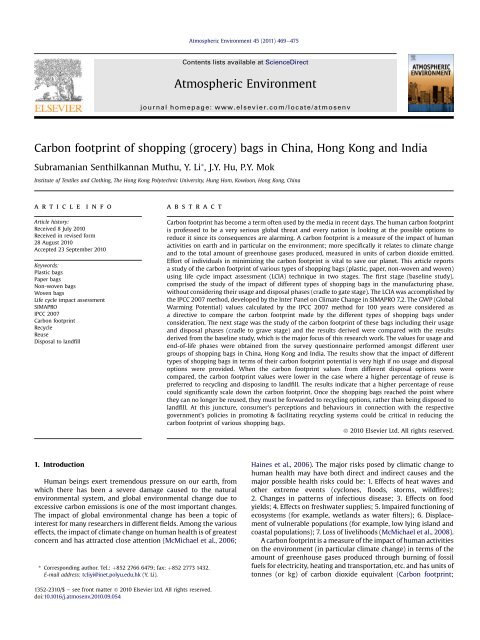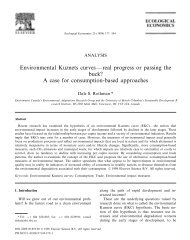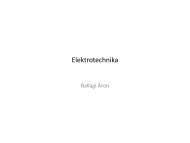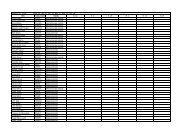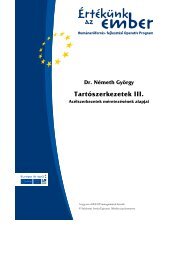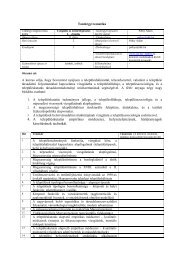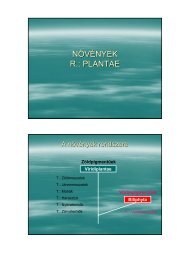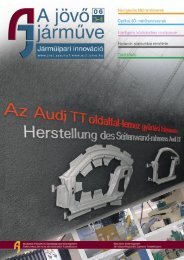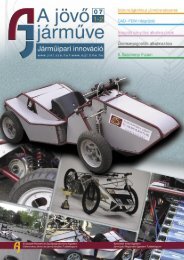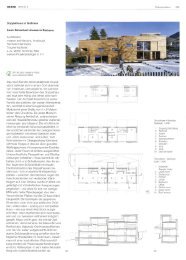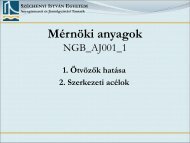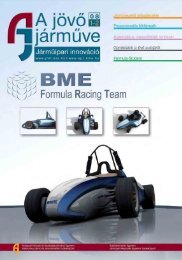Carbon footprint of shopping (grocery) bags in China, Hong Kong ...
Carbon footprint of shopping (grocery) bags in China, Hong Kong ...
Carbon footprint of shopping (grocery) bags in China, Hong Kong ...
You also want an ePaper? Increase the reach of your titles
YUMPU automatically turns print PDFs into web optimized ePapers that Google loves.
<strong>Carbon</strong> <strong>footpr<strong>in</strong>t</strong> <strong>of</strong> <strong>shopp<strong>in</strong>g</strong> (<strong>grocery</strong>) <strong>bags</strong> <strong>in</strong> Ch<strong>in</strong>a, <strong>Hong</strong> <strong>Kong</strong> and India<br />
Subramanian Senthilkannan Muthu, Y. Li *, J.Y. Hu, P.Y. Mok<br />
Institute <strong>of</strong> Textiles and Cloth<strong>in</strong>g, The <strong>Hong</strong> <strong>Kong</strong> Polytechnic University, Hung Hom, Kowloon, <strong>Hong</strong> <strong>Kong</strong>, Ch<strong>in</strong>a<br />
article <strong>in</strong>fo<br />
Article history:<br />
Received 8 July 2010<br />
Received <strong>in</strong> revised form<br />
28 August 2010<br />
Accepted 23 September 2010<br />
Keywords:<br />
Plastic <strong>bags</strong><br />
Paper <strong>bags</strong><br />
Non-woven <strong>bags</strong><br />
Woven <strong>bags</strong><br />
Life cycle impact assessment<br />
SIMAPRO<br />
IPCC 2007<br />
<strong>Carbon</strong> <strong>footpr<strong>in</strong>t</strong><br />
Recycle<br />
Reuse<br />
Disposal to landfill<br />
1. Introduction<br />
abstract<br />
Human be<strong>in</strong>gs exert tremendous pressure on our earth, from<br />
which there has been a severe damage caused to the natural<br />
environmental system, and global environmental change due to<br />
excessive carbon emissions is one <strong>of</strong> the most important changes.<br />
The impact <strong>of</strong> global environmental change has been a topic <strong>of</strong><br />
<strong>in</strong>terest for many researchers <strong>in</strong> different fields. Among the various<br />
effects, the impact <strong>of</strong> climate change on human health is <strong>of</strong> greatest<br />
concern and has attracted close attention (McMichael et al., 2006;<br />
* Correspond<strong>in</strong>g author. Tel.: þ852 2766 6479; fax: þ852 2773 1432.<br />
E-mail address: tcliyi@<strong>in</strong>et.polyu.edu.hk (Y. Li).<br />
1352-2310/$ e see front matter Ó 2010 Elsevier Ltd. All rights reserved.<br />
doi:10.1016/j.atmosenv.2010.09.054<br />
Atmospheric Environment 45 (2011) 469e475<br />
Contents lists available at ScienceDirect<br />
Atmospheric Environment<br />
journal homepage: www.elsevier.com/locate/atmosenv<br />
<strong>Carbon</strong> <strong>footpr<strong>in</strong>t</strong> has become a term <strong>of</strong>ten used by the media <strong>in</strong> recent days. The human carbon <strong>footpr<strong>in</strong>t</strong><br />
is pr<strong>of</strong>essed to be a very serious global threat and every nation is look<strong>in</strong>g at the possible options to<br />
reduce it s<strong>in</strong>ce its consequences are alarm<strong>in</strong>g. A carbon <strong>footpr<strong>in</strong>t</strong> is a measure <strong>of</strong> the impact <strong>of</strong> human<br />
activities on earth and <strong>in</strong> particular on the environment; more specifically it relates to climate change<br />
and to the total amount <strong>of</strong> greenhouse gases produced, measured <strong>in</strong> units <strong>of</strong> carbon dioxide emitted.<br />
Effort <strong>of</strong> <strong>in</strong>dividuals <strong>in</strong> m<strong>in</strong>imiz<strong>in</strong>g the carbon <strong>footpr<strong>in</strong>t</strong> is vital to save our planet. This article reports<br />
a study <strong>of</strong> the carbon <strong>footpr<strong>in</strong>t</strong> <strong>of</strong> various types <strong>of</strong> <strong>shopp<strong>in</strong>g</strong> <strong>bags</strong> (plastic, paper, non-woven and woven)<br />
us<strong>in</strong>g life cycle impact assessment (LCIA) technique <strong>in</strong> two stages. The first stage (basel<strong>in</strong>e study),<br />
comprised the study <strong>of</strong> the impact <strong>of</strong> different types <strong>of</strong> <strong>shopp<strong>in</strong>g</strong> <strong>bags</strong> <strong>in</strong> the manufactur<strong>in</strong>g phase,<br />
without consider<strong>in</strong>g their usage and disposal phases (cradle to gate stage). The LCIA was accomplished by<br />
the IPCC 2007 method, developed by the Inter Panel on Climate Change <strong>in</strong> SIMAPRO 7.2. The GWP (Global<br />
Warm<strong>in</strong>g Potential) values calculated by the IPCC 2007 method for 100 years were considered as<br />
a directive to compare the carbon <strong>footpr<strong>in</strong>t</strong> made by the different types <strong>of</strong> <strong>shopp<strong>in</strong>g</strong> <strong>bags</strong> under<br />
consideration. The next stage was the study <strong>of</strong> the carbon <strong>footpr<strong>in</strong>t</strong> <strong>of</strong> these <strong>bags</strong> <strong>in</strong>clud<strong>in</strong>g their usage<br />
and disposal phases (cradle to grave stage) and the results derived were compared with the results<br />
derived from the basel<strong>in</strong>e study, which is the major focus <strong>of</strong> this research work. The values for usage and<br />
end-<strong>of</strong>-life phases were obta<strong>in</strong>ed from the survey questionnaire performed amongst different user<br />
groups <strong>of</strong> <strong>shopp<strong>in</strong>g</strong> <strong>bags</strong> <strong>in</strong> Ch<strong>in</strong>a, <strong>Hong</strong> <strong>Kong</strong> and India. The results show that the impact <strong>of</strong> different<br />
types <strong>of</strong> <strong>shopp<strong>in</strong>g</strong> <strong>bags</strong> <strong>in</strong> terms <strong>of</strong> their carbon <strong>footpr<strong>in</strong>t</strong> potential is very high if no usage and disposal<br />
options were provided. When the carbon <strong>footpr<strong>in</strong>t</strong> values from different disposal options were<br />
compared, the carbon <strong>footpr<strong>in</strong>t</strong> values were lower <strong>in</strong> the case where a higher percentage <strong>of</strong> reuse is<br />
preferred to recycl<strong>in</strong>g and dispos<strong>in</strong>g to landfill. The results <strong>in</strong>dicate that a higher percentage <strong>of</strong> reuse<br />
could significantly scale down the carbon <strong>footpr<strong>in</strong>t</strong>. Once the <strong>shopp<strong>in</strong>g</strong> <strong>bags</strong> reached the po<strong>in</strong>t where<br />
they can no longer be reused, they must be forwarded to recycl<strong>in</strong>g options, rather than be<strong>in</strong>g disposed to<br />
landfill. At this juncture, consumer’s perceptions and behaviours <strong>in</strong> connection with the respective<br />
government’s policies <strong>in</strong> promot<strong>in</strong>g & facilitat<strong>in</strong>g recycl<strong>in</strong>g systems could be critical <strong>in</strong> reduc<strong>in</strong>g the<br />
carbon <strong>footpr<strong>in</strong>t</strong> <strong>of</strong> various <strong>shopp<strong>in</strong>g</strong> <strong>bags</strong>.<br />
Ó 2010 Elsevier Ltd. All rights reserved.<br />
Ha<strong>in</strong>es et al., 2006). The major risks posed by climatic change to<br />
human health may have both direct and <strong>in</strong>direct causes and the<br />
major possible health risks could be: 1. Effects <strong>of</strong> heat waves and<br />
other extreme events (cyclones, floods, storms, wildfires);<br />
2. Changes <strong>in</strong> patterns <strong>of</strong> <strong>in</strong>fectious disease; 3. Effects on food<br />
yields; 4. Effects on freshwater supplies; 5. Impaired function<strong>in</strong>g <strong>of</strong><br />
ecosystems (for example, wetlands as water filters); 6. Displacement<br />
<strong>of</strong> vulnerable populations (for example, low ly<strong>in</strong>g island and<br />
coastal populations); 7. Loss <strong>of</strong> livelihoods (McMichael et al., 2008).<br />
A carbon <strong>footpr<strong>in</strong>t</strong> is a measure <strong>of</strong> the impact <strong>of</strong> human activities<br />
on the environment (<strong>in</strong> particular climate change) <strong>in</strong> terms <strong>of</strong> the<br />
amount <strong>of</strong> greenhouse gases produced through burn<strong>in</strong>g <strong>of</strong> fossil<br />
fuels for electricity, heat<strong>in</strong>g and transportation, etc. and has units <strong>of</strong><br />
tonnes (or kg) <strong>of</strong> carbon dioxide equivalent (<strong>Carbon</strong> <strong>footpr<strong>in</strong>t</strong>;
470<br />
Hertwich and Peters, 2009). There are two types <strong>of</strong> carbon <strong>footpr<strong>in</strong>t</strong>s<br />
- primary and secondary. Primary <strong>footpr<strong>in</strong>t</strong>s, which are<br />
under our direct control, are the result <strong>of</strong> direct emissions <strong>of</strong> CO2<br />
from the burn<strong>in</strong>g <strong>of</strong> fossil fuels <strong>in</strong>clud<strong>in</strong>g domestic energy<br />
consumption and transportation (Ex: Usage <strong>of</strong> electricity and<br />
transportation, etc.). The secondary <strong>footpr<strong>in</strong>t</strong>s are related to the<br />
<strong>in</strong>direct CO2 emissions from the whole life cycle <strong>of</strong> the products<br />
human be<strong>in</strong>gs use - those associated with their manufacture and<br />
eventual breakdown (Ex: Usage <strong>of</strong> clothes and other products,<br />
recreation and leisure, etc) (Hertwich and Peters, 2009). Human<br />
be<strong>in</strong>gs are the major source <strong>of</strong> carbon emissions and they will be<br />
the most affected by the emissions, particularly those deemed<br />
serious.<br />
Production, usage and consumption <strong>of</strong> any product pose a threat<br />
to carbon <strong>footpr<strong>in</strong>t</strong>. Shopp<strong>in</strong>g <strong>bags</strong>, a symbol <strong>of</strong> the throw-away<br />
society, exacerbate the seriousness <strong>of</strong> the human carbon <strong>footpr<strong>in</strong>t</strong>.<br />
It is worthwhile study<strong>in</strong>g the entire life cycle phase <strong>of</strong> different<br />
types <strong>of</strong> <strong>shopp<strong>in</strong>g</strong> <strong>bags</strong> from the manufactur<strong>in</strong>g stage to the<br />
disposal stage. Once the product is decided to be disposed <strong>of</strong>, there<br />
may be three possibilities: reuse <strong>of</strong> the product for the same or for<br />
different purposes; recycle the product; dispose it <strong>of</strong>f to landfill.<br />
Human dimensions <strong>in</strong> consumer behaviour rule the decision <strong>of</strong><br />
a product’s disposal phase and consequently the environmental<br />
impact. Apart from human dimensions, governmental policies also<br />
assume greater significance <strong>in</strong> the environmental impact. There are<br />
many dimensions <strong>of</strong> environmental impact caused by <strong>shopp<strong>in</strong>g</strong><br />
<strong>bags</strong>; <strong>of</strong> which global environmental change is one <strong>of</strong> the prime<br />
concerns and this is discussed <strong>in</strong> detail <strong>in</strong> this article. Out <strong>of</strong> all the<br />
phases <strong>of</strong> a product’s life cycle, the disposal phase is very critically<br />
related to the environmental issues and is solely decided by the<br />
consumer’s attitude and the governmental policies to facilitate<br />
recycl<strong>in</strong>g <strong>of</strong> the product.<br />
There are different types <strong>of</strong> <strong>shopp<strong>in</strong>g</strong> <strong>bags</strong> available to cater for<br />
the <strong>shopp<strong>in</strong>g</strong> needs <strong>of</strong> people. A variety <strong>of</strong> raw materials and<br />
technologies are employed to manufacture them, the most popular<br />
<strong>of</strong> those are plastic, paper, non-woven and woven <strong>bags</strong>.<br />
Plastic <strong>bags</strong> are made from non-renewable resources, where the<br />
key <strong>in</strong>gredients are petroleum and natural gas. Polyethylene-high<br />
density (HDPE), low density (LDPE), l<strong>in</strong>ear low-density polyethylene<br />
(LLDPE) are the raw materials widely used for the<br />
manufacture <strong>of</strong> plastic <strong>bags</strong> (Lajeunesse, 2004). The <strong>shopp<strong>in</strong>g</strong> <strong>bags</strong><br />
used by super markets are ideally produced out <strong>of</strong> LLDPE to get the<br />
desired thickness and glossy look. And if one needs very th<strong>in</strong> and<br />
gauzy <strong>bags</strong> then LDPE would be an ideal choice (Dilli, 2007). A very<br />
detailed explanation <strong>of</strong> plastic <strong>bags</strong> manufactur<strong>in</strong>g process can be<br />
referred from (Muthu et al., 2009).<br />
Paper <strong>bags</strong> are made out <strong>of</strong> pulpwood from trees, which is<br />
a renewable source. However, we get paper <strong>bags</strong> from fell<strong>in</strong>g trees,<br />
which destroys both plants and animals and the production process<br />
engrosses energy created by coal or natural gas. The created pulp<br />
will be converted <strong>in</strong>to a paper bag by different processes and<br />
mach<strong>in</strong>es after consum<strong>in</strong>g a tremendous amount <strong>of</strong> energy from<br />
fossil fuels, electricity, various chemicals, etc. (Decker and Graff).<br />
Further details about the paper bag manufactur<strong>in</strong>g process can be<br />
referred from (Muthu et al., 2009).<br />
Although non-woven <strong>bags</strong> made from many different types <strong>of</strong><br />
raw materials are available today <strong>in</strong> the market, the ones made <strong>of</strong><br />
polypropylene (PP) are most commonly seen for <strong>shopp<strong>in</strong>g</strong><br />
purposes (Muthu et al., 2010b). The production process <strong>of</strong> a woven<br />
bag made out <strong>of</strong> cotton is cumbersome compared to that <strong>of</strong><br />
a non-woven bag and further details <strong>of</strong> this process can be referred<br />
from (Muthu et al., 2010b).<br />
All products have an impact on the planet. Quantify<strong>in</strong>g<br />
the impact is crucial to reduce it. Among many techniques to study<br />
the eco-impact <strong>of</strong> a product, life cycle assessment (LCA) is one<br />
S.S. Muthu et al. / Atmospheric Environment 45 (2011) 469e475<br />
<strong>of</strong> the most widely used and popular ones. LCA exam<strong>in</strong>es the<br />
product from its <strong>in</strong>itial (cradle stage) to f<strong>in</strong>al stage (grave stage),<br />
covers its entire life cycle, and also evaluates the product <strong>in</strong> terms <strong>of</strong><br />
the environmental impact dur<strong>in</strong>g its life time.<br />
A life cycle assessment (LCA) is an analytical tool which can help<br />
to understand the environmental impacts from the acquisition <strong>of</strong><br />
raw materials to f<strong>in</strong>al disposal (SETAC, 1993).<br />
In accordance with the def<strong>in</strong>ition given by The Society <strong>of</strong> Environmental<br />
Toxicology and Chemistry (SETAC), LCA is an iterative<br />
process for evaluat<strong>in</strong>g the environmental burdens associated with<br />
a product, process or activity by identify<strong>in</strong>g and quantify<strong>in</strong>g energy<br />
and materials used and wastes released to the environment. LCA<br />
can also be used to assess the impact <strong>of</strong> those energy and materials<br />
used and released to the environment and can help to identify and<br />
evaluate opportunities to effect environmental improvements. The<br />
assessment <strong>in</strong>cludes the entire life cycle <strong>of</strong> the product, process or<br />
activity, encompass<strong>in</strong>g extract<strong>in</strong>g and process<strong>in</strong>g raw materials;<br />
manufactur<strong>in</strong>g, transportation and distribution, use, reuse, ma<strong>in</strong>tenance,<br />
recycl<strong>in</strong>g and f<strong>in</strong>al disposal (Fava et al., 1991). Accord<strong>in</strong>g to<br />
ISO 14040, an LCA study essentially consists <strong>of</strong> four <strong>in</strong>terconnected<br />
steps/phases (ISO 14040, 2006):<br />
Goal and scope def<strong>in</strong>ition<br />
Inventory analysis<br />
Impact Assessment<br />
Interpretation<br />
Further details about life cycle assessment (LCA) can be found <strong>in</strong><br />
(Muthu et al., 2009; SETAC, 1993; Fava et al., 1991; ISO 14040, 2006;<br />
ISO 14044, 2006).<br />
Shopp<strong>in</strong>g <strong>bags</strong>, as an example <strong>of</strong> unnecessary waste, require LCA<br />
to assess the environmental impact <strong>in</strong> terms <strong>of</strong> their carbon <strong>footpr<strong>in</strong>t</strong>.<br />
A large number <strong>of</strong> studies have been conducted to <strong>in</strong>vestigate<br />
the LCA <strong>of</strong> various <strong>shopp<strong>in</strong>g</strong> <strong>bags</strong> (Muthu et al., 2009, 2010b;<br />
Brower et al., 1999; Chaffee and Yaros, 2007; Ecobilan, 2008;<br />
Nolan ITU et al., 2002; ExcelPlas Australia et al., 2004; James<br />
and Grant, 2005; FRIDGE; Los Angeles County Department <strong>of</strong><br />
Public Works, 2007; Paper vs. Plastic Bags, 1990; Ellis et al., 2005;<br />
www.susta<strong>in</strong>ability-ed.org). Most <strong>of</strong> the studies focused on plastic<br />
and paper <strong>bags</strong>. However, very little work has been done on nonwoven<br />
and woven <strong>bags</strong> compared to plastic and paper <strong>bags</strong>. And<br />
also there have been no published articles till date focus<strong>in</strong>g<br />
primarily on the carbon <strong>footpr<strong>in</strong>t</strong> created by <strong>shopp<strong>in</strong>g</strong> <strong>bags</strong>.<br />
Research <strong>in</strong>to the <strong>in</strong>fluence <strong>of</strong> the consumer’s attitude and<br />
governmental policies on this is entirely lack<strong>in</strong>g. This article bridges<br />
the gaps identified above and also describes the impact <strong>of</strong> different<br />
types <strong>of</strong> <strong>shopp<strong>in</strong>g</strong> <strong>bags</strong> on the human carbon <strong>footpr<strong>in</strong>t</strong> and also<br />
how consumer and policy dimensions <strong>in</strong>fluence it.<br />
Consumer behaviour and governmental policies play an<br />
important role <strong>in</strong> the disposal stage <strong>of</strong> <strong>shopp<strong>in</strong>g</strong> <strong>bags</strong>. Notwithstand<strong>in</strong>g<br />
the capability <strong>of</strong> certa<strong>in</strong> types <strong>of</strong> <strong>bags</strong> to be recycled and<br />
reused, it is <strong>in</strong> the hands <strong>of</strong> customers to reuse a bag until it can be<br />
discarded or recycled, i.e. to reuse the <strong>shopp<strong>in</strong>g</strong> <strong>bags</strong> many times<br />
till they can be disposed <strong>of</strong> and to keep them <strong>in</strong> recycl<strong>in</strong>g b<strong>in</strong>s<br />
provided by the government, rather than dispose to landfill, which<br />
is detrimental to the environment as far as eco-impact is concerned.<br />
It is the responsibility <strong>of</strong> government to provide more<br />
recycl<strong>in</strong>g options and viable policies to set th<strong>in</strong>gs <strong>in</strong> place <strong>in</strong> terms<br />
<strong>of</strong> recycl<strong>in</strong>g. Frequent promotion <strong>of</strong> recycl<strong>in</strong>g options by government<br />
and the behaviour <strong>of</strong> the consumer to reuse the <strong>shopp<strong>in</strong>g</strong><br />
<strong>bags</strong> till they can be discarded is crucial <strong>in</strong> reduc<strong>in</strong>g the carbon<br />
<strong>footpr<strong>in</strong>t</strong>.<br />
To determ<strong>in</strong>e the attitude <strong>of</strong> users <strong>of</strong> <strong>shopp<strong>in</strong>g</strong> <strong>bags</strong> and to<br />
understand the disposal scenarios, a questionnaire survey was<br />
conducted <strong>in</strong> Ch<strong>in</strong>a, <strong>Hong</strong> <strong>Kong</strong> and India among different user
groups <strong>of</strong> <strong>shopp<strong>in</strong>g</strong> <strong>bags</strong> and the f<strong>in</strong>d<strong>in</strong>gs are reported <strong>in</strong> (Muthu<br />
et al., 2010a). These three territories were particularly chosen,<br />
s<strong>in</strong>ce the authors are from these territories and they <strong>in</strong>tend to<br />
create awareness and consequently educate people <strong>of</strong> the country<br />
to which they belong to. The aims <strong>of</strong> the survey lie <strong>in</strong> comprehend<strong>in</strong>g<br />
how different user groups use and dispose plastic, paper,<br />
non-woven and woven <strong>bags</strong>. Usage and disposal behaviors are<br />
def<strong>in</strong>ed as how many times people reuse different <strong>shopp<strong>in</strong>g</strong> <strong>bags</strong>,<br />
what percentage <strong>of</strong> <strong>shopp<strong>in</strong>g</strong> <strong>bags</strong> can be recycled/sent to landfill<br />
with the exist<strong>in</strong>g possibilities <strong>of</strong> recycl<strong>in</strong>g <strong>in</strong> their own country and<br />
what percentage <strong>of</strong> <strong>shopp<strong>in</strong>g</strong> <strong>bags</strong> people perceive can be reused/<br />
recycled/sent to landfill. Also this survey <strong>in</strong>tends to comprehend<br />
the exist<strong>in</strong>g recycl<strong>in</strong>g options provided by the government and the<br />
will<strong>in</strong>gness <strong>of</strong> people to support the government’s policies further<br />
to improve the possibilities <strong>of</strong> recycl<strong>in</strong>g.<br />
2. Research methodology<br />
2.1. Study <strong>of</strong> impact <strong>of</strong> various <strong>shopp<strong>in</strong>g</strong> <strong>bags</strong> on carbon <strong>footpr<strong>in</strong>t</strong><br />
This paper revolves around the study <strong>of</strong> global climate change<br />
due to the production, usage and disposal phases <strong>of</strong> various types <strong>of</strong><br />
<strong>shopp<strong>in</strong>g</strong> <strong>bags</strong> <strong>in</strong> Ch<strong>in</strong>a, <strong>Hong</strong> <strong>Kong</strong> and India. The <strong>in</strong>itial step <strong>of</strong> this<br />
study is the collection <strong>of</strong> secondary data for Life cycle <strong>in</strong>ventory<br />
(LCI) for various types <strong>of</strong> <strong>shopp<strong>in</strong>g</strong> <strong>bags</strong> for the three countries<br />
under consideration <strong>in</strong> this present study. For different types <strong>of</strong><br />
<strong>shopp<strong>in</strong>g</strong> <strong>bags</strong> such as plastic (HDPE), paper (Kraft), non-woven<br />
(PP) <strong>bags</strong> and woven cotton <strong>bags</strong>, the data were obta<strong>in</strong>ed from the<br />
f<strong>in</strong>al report prepared for Environment Australia <strong>in</strong> 2002 (Nolan ITU<br />
et al., 2002). An LCI <strong>of</strong> different types <strong>of</strong> <strong>shopp<strong>in</strong>g</strong> <strong>bags</strong> under<br />
consideration <strong>in</strong> this study also appears <strong>in</strong> an updated version <strong>of</strong><br />
this study published <strong>in</strong> 2004 (ExcelPlas Australia et al., 2004). The<br />
basic data referred from these sources were converted to the<br />
functional unit assumed for Ch<strong>in</strong>a, <strong>Hong</strong> <strong>Kong</strong> and India.<br />
The data aris<strong>in</strong>g from this study <strong>in</strong>cluded the total energy<br />
consumed by a bag to get it manufactured, where total energy<br />
represents process and feedstock energy and the quantity <strong>of</strong><br />
pollutants emitted to the atmosphere dur<strong>in</strong>g the manufactur<strong>in</strong>g<br />
process.<br />
The goal <strong>of</strong> the study under discussion is to analyse the carbon<br />
<strong>footpr<strong>in</strong>t</strong> <strong>of</strong> these four types <strong>of</strong> <strong>bags</strong> <strong>in</strong> Ch<strong>in</strong>a, <strong>Hong</strong> <strong>Kong</strong> and India<br />
with the available data from a secondary source (cradle to gate) <strong>in</strong><br />
the first step and <strong>in</strong> the second step, to study the effect <strong>of</strong><br />
consumer’s attitude and policy dimensions <strong>in</strong> the carbon <strong>footpr<strong>in</strong>t</strong><br />
<strong>of</strong> these four types <strong>of</strong> <strong>shopp<strong>in</strong>g</strong> <strong>bags</strong> (cradle to grave). The scope <strong>of</strong><br />
this study <strong>in</strong>cludes the comparative <strong>in</strong>vestigation <strong>of</strong> carbon <strong>footpr<strong>in</strong>t</strong><br />
<strong>of</strong> plastic, paper, non-woven and woven <strong>shopp<strong>in</strong>g</strong> <strong>bags</strong> <strong>in</strong><br />
both cradle to gate and grave states from the data sources<br />
mentioned above <strong>in</strong> Ch<strong>in</strong>a, <strong>Hong</strong> <strong>Kong</strong> and India. The cradle to gate<br />
assessment phase <strong>of</strong> this study considers impacts at each life cycle<br />
stage <strong>of</strong> four types <strong>of</strong> <strong>shopp<strong>in</strong>g</strong> <strong>bags</strong> under consideration which<br />
<strong>in</strong>cludes extraction/process<strong>in</strong>g or grow<strong>in</strong>g/harvest<strong>in</strong>g <strong>of</strong> resources;<br />
the process <strong>of</strong> manufactur<strong>in</strong>g; transport from the manufacturer to<br />
the wholesaler/retailer as <strong>in</strong>dicated <strong>in</strong> the secondary data sources<br />
from which the cradle to gate data were referred. For cradle to grave<br />
stage, public op<strong>in</strong>ion from Ch<strong>in</strong>a, <strong>Hong</strong> <strong>Kong</strong> and India on<br />
percentage <strong>of</strong> reuse, recycle and disposal to landfill were considered<br />
to build the end-<strong>of</strong>-life scenarios <strong>in</strong> addition to the above<br />
mentioned areas <strong>in</strong> cradle to gate stage.<br />
To derive the functional unit which suits better for the three<br />
territories considered, the consumption statistics <strong>of</strong> <strong>shopp<strong>in</strong>g</strong> <strong>bags</strong><br />
was referred from the literature perta<strong>in</strong><strong>in</strong>g to Ch<strong>in</strong>a, <strong>Hong</strong> <strong>Kong</strong><br />
and India. Among the four <strong>bags</strong> under consideration <strong>in</strong> this present<br />
study, statistics were readily available on the consumption <strong>of</strong><br />
plastic <strong>bags</strong>. As per our currently available literature survey on<br />
S.S. Muthu et al. / Atmospheric Environment 45 (2011) 469e475 471<br />
statistics on <strong>shopp<strong>in</strong>g</strong> <strong>bags</strong> consumption, an average Ch<strong>in</strong>ese and<br />
a <strong>Hong</strong> <strong>Kong</strong> resident, on an average uses 3 plastic <strong>bags</strong> per day<br />
(EPD, HK, 2009; Environmental News Network, 2008). Although<br />
there is no readily available statistics for the usage <strong>of</strong> plastic <strong>bags</strong> <strong>in</strong><br />
India compared to <strong>Hong</strong> <strong>Kong</strong> and Ch<strong>in</strong>a (Bus<strong>in</strong>essgreen.com, 2010;<br />
The Times <strong>of</strong> India, 2009), as per one <strong>of</strong> the references perta<strong>in</strong><strong>in</strong>g to<br />
the consumption <strong>of</strong> plastic <strong>bags</strong> <strong>in</strong> India, India’s per capita<br />
consumption is 150 plastic <strong>bags</strong> a year (Onl<strong>in</strong>e Edition <strong>of</strong> The H<strong>in</strong>du,<br />
2010).<br />
The functional unit <strong>of</strong> this present study is the, “number <strong>of</strong><br />
<strong>shopp<strong>in</strong>g</strong> <strong>bags</strong> used for <strong>grocery</strong> <strong>shopp<strong>in</strong>g</strong> per year by an average<br />
Ch<strong>in</strong>ese/Indian/HK resident”. For the territories considered for this<br />
study, we assume that plastic and paper <strong>bags</strong> are comparable and<br />
they are equivalent to each other <strong>in</strong> their functional front. When it<br />
comes to non-woven and woven <strong>bags</strong>, we assume that 1 nonwoven<br />
and 2 woven cotton <strong>bags</strong> will replace 100 s<strong>in</strong>gle use plastic<br />
and paper <strong>bags</strong>. Further, our above said assumptions can be validated<br />
from the relevant literature also (Nolan ITU et al., 2002;<br />
ExcelPlas Australia et al., 2004; James and Grant, 2005; Reusable<br />
<strong>shopp<strong>in</strong>g</strong> <strong>bags</strong>; Envirosax; Alburyenviro<strong>bags</strong>). Hence 1095 plastic<br />
and paper <strong>bags</strong>, 10.95 non-woven and 21.9 woven <strong>bags</strong> are required<br />
to fulfill the functional unit assumed for this study for an average<br />
Ch<strong>in</strong>ese and HK residents. For Indians, 150 plastic and paper <strong>bags</strong>,<br />
1.5 non-woven and 3 woven <strong>bags</strong> are needed to fulfill this study’s<br />
functional unit.<br />
The end-<strong>of</strong>-life values were derived from a survey conducted <strong>in</strong><br />
Ch<strong>in</strong>a, <strong>Hong</strong> <strong>Kong</strong> and India as reported <strong>in</strong> the references <strong>in</strong> detail<br />
(Muthu et al., 2010a). Results from the survey were used <strong>in</strong> Life<br />
cycle impact calculations <strong>in</strong> the usage and disposal states were<br />
compared with the life cycle stage without usage and disposal<br />
criteria.<br />
2.2. Life cycle <strong>in</strong>ventory (LCI) <strong>of</strong> <strong>shopp<strong>in</strong>g</strong> <strong>bags</strong><br />
The energy and pollutants data for the functional unit considered<br />
for different <strong>shopp<strong>in</strong>g</strong> <strong>bags</strong> under consideration <strong>in</strong> this present<br />
study was taken from the previous studies (Nolan ITU et al., 2002;<br />
ExcelPlas Australia et al., 2004) and is tabulated <strong>in</strong> Table 1 for Ch<strong>in</strong>a<br />
and <strong>Hong</strong> <strong>Kong</strong> and Table 2 for India.<br />
2.3. Survey results <strong>of</strong> usage and disposal behaviour<br />
<strong>of</strong> <strong>shopp<strong>in</strong>g</strong> <strong>bags</strong><br />
The major focus <strong>of</strong> this study is to <strong>in</strong>vestigate the <strong>in</strong>fluence <strong>of</strong><br />
human behaviour and governmental policies on the carbon <strong>footpr<strong>in</strong>t</strong><br />
<strong>of</strong> various types <strong>of</strong> <strong>shopp<strong>in</strong>g</strong> <strong>bags</strong>. A survey was conducted<br />
among students, home makers and employed pr<strong>of</strong>essionals <strong>in</strong><br />
various pr<strong>of</strong>essions <strong>of</strong> different age groups, who are the users <strong>of</strong><br />
<strong>shopp<strong>in</strong>g</strong> <strong>bags</strong> and who have the knowledge on the usage and<br />
disposal behaviour <strong>of</strong> the same <strong>in</strong> Ch<strong>in</strong>a, <strong>Hong</strong> <strong>Kong</strong> and India. This<br />
survey was ma<strong>in</strong>ly aimed at understand<strong>in</strong>g the consumer’s<br />
perception <strong>of</strong> reuse, recycle and disposal to landfill, recycl<strong>in</strong>g<br />
Table 1<br />
Life cycle <strong>in</strong>ventory data <strong>of</strong> plastic, paper, non-woven and woven <strong>bags</strong> <strong>in</strong> Ch<strong>in</strong>a and<br />
<strong>Hong</strong> <strong>Kong</strong>.<br />
Alternative Weight/bag Bags/year Material Green house Primary<br />
consumption gas emissions<br />
(CO2 eq.)<br />
energy<br />
Plastic bag 6 g 1095 6.57 kg 12.8 kg 442.2 MJ<br />
Paper bag 42.6 g 1095 46.65 kg 24.8 kg 1518.3 MJ<br />
PP fibre nonwoven<br />
bag<br />
65.6 g 10.95 718.32 g 5.17 kg 122.2 MJ<br />
Woven<br />
cotton bag<br />
125.4 g 21.9 2.75 kg 6.06 kg 385 MJ
472<br />
Table 2<br />
Life cycle <strong>in</strong>ventory data <strong>of</strong> plastic, paper, non-woven and woven <strong>bags</strong> <strong>in</strong> India.<br />
Alternative Weight/bag Bags/year Material<br />
consumption<br />
possibilities with the exist<strong>in</strong>g government provisions/policies for<br />
recycl<strong>in</strong>g, will<strong>in</strong>gness to support recycl<strong>in</strong>g systems/policies to<br />
reduce the percentage <strong>of</strong> landfill and so on (Muthu et al., 2010a).<br />
The major results extracted from this survey are presented <strong>in</strong><br />
Table 3.<br />
From the survey results, usage and end-<strong>of</strong>-life scenario values<br />
are deduced to the follow<strong>in</strong>g categories, which can be seen from<br />
Table 3.<br />
3. Results and discussions<br />
Green house<br />
gas emissions<br />
(CO2-eq.)<br />
3.1. Life cycle assessment analysis and results without<br />
usage and disposal options<br />
Primary<br />
energy<br />
Plastic bag 6 g 150 900 g 1.74 kg 60 MJ<br />
Paper bag 42.6 g 150 6.39 kg 3.41 kg 210 MJ<br />
PP fibre nonwoven<br />
bag<br />
65.6 g 1.5 98.4 g 708 g 16.73 MJ<br />
Woven cotton<br />
bag<br />
125.4 g 3 376.2 g 831 g 52.74 MJ<br />
In this section, energy and pollutants data were processed by<br />
us<strong>in</strong>g one <strong>of</strong> the commercial LCA s<strong>of</strong>twareseSIMAPRO 7.2. The IPCC<br />
2007 method (IPCC method) for LCIA was employed to assess the<br />
carbon <strong>footpr<strong>in</strong>t</strong>, which is expressed <strong>in</strong> terms <strong>of</strong> Global Warm<strong>in</strong>g<br />
Potential <strong>of</strong> 20 years, 100 and 500 years. LCIA modell<strong>in</strong>g was done<br />
<strong>in</strong> three phases: Global Warm<strong>in</strong>g Potential <strong>of</strong> 20 years, 100 and 500<br />
years by us<strong>in</strong>g the same method for Ch<strong>in</strong>a and <strong>Hong</strong> <strong>Kong</strong> separately<br />
and for India separately as per the functional unit assumption.<br />
Results <strong>of</strong> these analyses can be seen from Fig. 1 for Ch<strong>in</strong>a and<br />
<strong>Hong</strong> <strong>Kong</strong> and Fig. 2 for India. For the functional unit assumed,<br />
non-woven <strong>bags</strong> made out <strong>of</strong> polypropylene score out all other<br />
<strong>bags</strong>, followed by woven cotton <strong>bags</strong> <strong>in</strong> the three territories<br />
considered for this study. Plastic <strong>bags</strong> and paper <strong>bags</strong> have very<br />
high global warm<strong>in</strong>g potential for 20, 100 and 500 years compared<br />
to non-woven and woven <strong>bags</strong>. Life cycle <strong>in</strong>ventory data presented<br />
<strong>in</strong> Tables 1 and 2 clearly enumerate these results and <strong>in</strong>dicate that<br />
non-woven <strong>bags</strong> occupy better position <strong>in</strong> this comparative analysis.<br />
For the functional unit assumed, non-woven <strong>bags</strong> consume<br />
lesser energy and fewer amounts <strong>of</strong> materials and also they emit<br />
lesser green house gas emissions <strong>in</strong> the production phase <strong>of</strong><br />
<strong>shopp<strong>in</strong>g</strong> <strong>bags</strong> <strong>in</strong> comparison with its counterparts <strong>in</strong> Ch<strong>in</strong>a, <strong>Hong</strong><br />
<strong>Kong</strong> and India.<br />
Accord<strong>in</strong>g to the first part <strong>of</strong> this study, paper <strong>bags</strong> seem to be<br />
very much detrimental to the environment <strong>in</strong> terms <strong>of</strong> more<br />
amounts <strong>of</strong> carbon emissions compared to its counterparts as per<br />
the secondary data source references. However this can be further<br />
studied with the <strong>in</strong>clusion <strong>of</strong> the positive effect <strong>of</strong> the photo<br />
synthesis effect created by trees, from where the paper is primarily<br />
be<strong>in</strong>g made. This part certa<strong>in</strong>ly needs to be <strong>in</strong>cluded <strong>in</strong> the carbon<br />
<strong>footpr<strong>in</strong>t</strong> modell<strong>in</strong>g part.<br />
Table 3<br />
Values for usage and disposal options from survey results (Muthu et al., 2010a).<br />
S.S. Muthu et al. / Atmospheric Environment 45 (2011) 469e475<br />
3.2. Life cycle assessment analysis and results with usage<br />
and disposal options<br />
The results <strong>of</strong> the survey f<strong>in</strong>d<strong>in</strong>gs tabulated <strong>in</strong> Table 3 were<br />
employed to <strong>in</strong>vestigate the impact <strong>of</strong> plastic, paper <strong>bags</strong>, nonwoven<br />
and woven <strong>bags</strong> on carbon <strong>footpr<strong>in</strong>t</strong> <strong>in</strong> terms <strong>of</strong> global<br />
warm<strong>in</strong>g potential and they were compared with the results<br />
obta<strong>in</strong>ed from without usage and disposal options (basel<strong>in</strong>e study).<br />
The GWP results <strong>of</strong> the same for Ch<strong>in</strong>a, <strong>Hong</strong> <strong>Kong</strong> and India are<br />
described <strong>in</strong> Figs. 3 and 4 respectively. For better clarity and ease <strong>of</strong><br />
comparison, only the results from 100 years are considered for this<br />
discussion.<br />
The data tabulated <strong>in</strong> Figs. 3 and 4 permit a comparative<br />
<strong>in</strong>vestigation between, without and with usage and disposal<br />
options accord<strong>in</strong>g to the exist<strong>in</strong>g consumer behaviour and<br />
government policies <strong>in</strong> Ch<strong>in</strong>a, <strong>Hong</strong> <strong>Kong</strong> and India. In all the cases,<br />
the carbon <strong>footpr<strong>in</strong>t</strong> values are less than those <strong>of</strong> the without usage<br />
and disposal options. When the comparison is made between the<br />
options from three countries under discussion here, one can see<br />
that for plastic <strong>bags</strong>, the carbon <strong>footpr<strong>in</strong>t</strong> values from India is less<br />
compared to other countries. This is due to the fact that reuse<br />
option is most selected by Indians for plastic <strong>bags</strong>. For other categories<br />
<strong>of</strong> <strong>shopp<strong>in</strong>g</strong> <strong>bags</strong>, the carbon <strong>footpr<strong>in</strong>t</strong> values from Ch<strong>in</strong>a are<br />
less, due to the same fact mentioned above. The <strong>in</strong>fluence <strong>of</strong> reuse<br />
option on reduc<strong>in</strong>g carbon <strong>footpr<strong>in</strong>t</strong> values is very much pert<strong>in</strong>ent<br />
<strong>in</strong> all the cases under discussion here. While look<strong>in</strong>g at the results<br />
<strong>in</strong> Table 3 for woven <strong>bags</strong> <strong>in</strong> Ch<strong>in</strong>a and <strong>Hong</strong> <strong>Kong</strong>, we can notice<br />
that a 5% difference <strong>in</strong> percentage <strong>of</strong> reuse results <strong>in</strong> 22 Kg CO2<br />
equivalents <strong>of</strong> global warm<strong>in</strong>g potential (around 20% <strong>of</strong> GWP) <strong>in</strong><br />
Fig. 3, which showcases the importance <strong>of</strong> reuse option. It is a wellknown<br />
fact that the more reuse <strong>of</strong> <strong>shopp<strong>in</strong>g</strong> <strong>bags</strong>, lesser will be the<br />
environmental impact. However the magnitude <strong>of</strong> importance<br />
needs to be revealed, which will portray the real scenario to the<br />
consumers <strong>of</strong> <strong>shopp<strong>in</strong>g</strong> <strong>bags</strong>. Even 1% <strong>of</strong> more reuse <strong>of</strong> <strong>shopp<strong>in</strong>g</strong><br />
<strong>bags</strong> will make a world <strong>of</strong> difference <strong>in</strong> terms <strong>of</strong> environmental<br />
impact, which has to be unveiled to public, if one wants them to be<br />
educated <strong>in</strong> terms <strong>of</strong> environmental improvement. If we expect the<br />
Percentage Plastic <strong>bags</strong> Paper <strong>bags</strong> Non-woven <strong>bags</strong> Woven <strong>bags</strong><br />
Ch<strong>in</strong>a HK India Ch<strong>in</strong>a HK India Ch<strong>in</strong>a HK India Ch<strong>in</strong>a HK India<br />
Recycle 21% 22% 18% 31% 25% 25% 22% 25% 21% 20% 23% 27%<br />
Reuse 46% 42% 55% 42% 38% 28% 78% 69% 55% 80% 75% 73%<br />
Sent to landfill 33% 36% 27% 27% 37% 47% 0% 6% 24% 0% 2% 0%<br />
2500<br />
2000<br />
1500<br />
1000<br />
500<br />
0<br />
Plastic Bags Paper Bags Non-woven <strong>bags</strong> Woven Bags<br />
GWP (KgCo2-eq.) <strong>in</strong> 20 Years<br />
GWP (KgCo2-eq.) <strong>in</strong> 100 Years<br />
GWP (KgCo2-eq.) <strong>in</strong> 500 Years<br />
Fig. 1. <strong>Carbon</strong> <strong>footpr<strong>in</strong>t</strong> results without usage and disposal options <strong>in</strong> Ch<strong>in</strong>a and <strong>Hong</strong><br />
<strong>Kong</strong> (Results rounded-<strong>of</strong>f).
350<br />
300<br />
250<br />
200<br />
150<br />
100<br />
50<br />
0<br />
Plastic Bags Paper Bags Non-woven <strong>bags</strong> Woven Bags<br />
GWP (KgCo2-eq.) <strong>in</strong> 20 Years<br />
GWP (KgCo2-eq.) <strong>in</strong> 100 Years<br />
GWP (KgCo2-eq.) <strong>in</strong> 500 Years<br />
Fig. 2. <strong>Carbon</strong> <strong>footpr<strong>in</strong>t</strong> results without usage and disposal options <strong>in</strong> India (Results<br />
rounded-<strong>of</strong>f).<br />
Woven <strong>bags</strong><br />
Non-woven <strong>bags</strong><br />
Paper <strong>bags</strong><br />
Plastic <strong>bags</strong><br />
0 500 1000 1500 2000<br />
GWP(KgCo2-eq.) <strong>in</strong> 100 Years<br />
Basel<strong>in</strong>e study Ch<strong>in</strong>a HK<br />
Fig. 3. <strong>Carbon</strong> <strong>footpr<strong>in</strong>t</strong> results with usage and disposal options <strong>in</strong> Ch<strong>in</strong>a and <strong>Hong</strong><br />
<strong>Kong</strong> (Results rounded-<strong>of</strong>f).<br />
Woven <strong>bags</strong><br />
Non-woven<br />
<strong>bags</strong><br />
Paper <strong>bags</strong><br />
Plastic <strong>bags</strong><br />
0 50 100 150 200 250<br />
GWP(KgCo2-eq.) <strong>in</strong> 100 Years<br />
Basel<strong>in</strong>e study India<br />
Fig. 4. <strong>Carbon</strong> <strong>footpr<strong>in</strong>t</strong> results with usage and disposal options <strong>in</strong> India (Results<br />
rounded-<strong>of</strong>f).<br />
public to appreciate the environmental education <strong>in</strong> terms <strong>of</strong> their<br />
contribution to reduce environmental impact, they should be<br />
aware <strong>of</strong> the real values <strong>of</strong> environmental impact. Based on the<br />
above results and discussions, one important po<strong>in</strong>t to be noted here<br />
is, if any product is not reused till the end <strong>of</strong> its life, the concerns<br />
about environmental impact are huge. On the other hand if any<br />
product is not recycled and sent to landfill more, the eco-impact<br />
S.S. Muthu et al. / Atmospheric Environment 45 (2011) 469e475 473<br />
Fig. 5. Recycl<strong>in</strong>g System <strong>in</strong> Ch<strong>in</strong>a (Shenzhen City).<br />
Fig. 6. Recycl<strong>in</strong>g System <strong>in</strong> <strong>Hong</strong> <strong>Kong</strong> (Hung Hom Area).<br />
concerns are more acute than the manufactur<strong>in</strong>g and usage state,<br />
which can be understood from the results <strong>of</strong> this research work. So,<br />
usage and disposal <strong>of</strong> <strong>shopp<strong>in</strong>g</strong> <strong>bags</strong> assumes greater significance<br />
<strong>in</strong> m<strong>in</strong>imiz<strong>in</strong>g the carbon <strong>footpr<strong>in</strong>t</strong>.<br />
If policies <strong>of</strong> these governments have been reconsidered and<br />
recycl<strong>in</strong>g systems are encouraged and if they are <strong>in</strong> their appropriate<br />
places, percentage <strong>of</strong> recycl<strong>in</strong>g options will be <strong>in</strong>creased and<br />
it is beyond anybody’s doubt that the impact <strong>of</strong> global climatic<br />
change will come down enormously. Though governmental policies<br />
to promote recycl<strong>in</strong>g can be seen all around the globe, still<br />
they need to be up to the mark; thereby every <strong>in</strong>dividual goes for<br />
it. As far as Ch<strong>in</strong>a and <strong>Hong</strong> <strong>Kong</strong> is concerned, recycl<strong>in</strong>g systems<br />
can be seen <strong>in</strong> major areas, some photos taken <strong>in</strong> Ch<strong>in</strong>a<br />
Fig. 7. Recycl<strong>in</strong>g B<strong>in</strong>s from an apartment <strong>in</strong> HK.
474<br />
(Shenzhen) and <strong>Hong</strong> <strong>Kong</strong> (Hung Hom) are presented <strong>in</strong> Figs.5<br />
and 6. Also <strong>in</strong> order to support government’s activities, <strong>in</strong>dividuals<br />
also need to take some <strong>in</strong>itiative to promote recycl<strong>in</strong>g activity.<br />
One typical example is the <strong>in</strong>itiative taken by residents <strong>of</strong> an<br />
apartment <strong>in</strong> <strong>Hong</strong> <strong>Kong</strong> to promote recycl<strong>in</strong>g options, which can<br />
be seen from Figs.7 and 8. Such activities should be <strong>in</strong>itiated and<br />
cont<strong>in</strong>ued by all <strong>in</strong>dividuals.<br />
The emphasis on <strong>in</strong>terpretation phase <strong>of</strong> this analysis is not on<br />
conclud<strong>in</strong>g which one is much better. Actually the conclusion needs<br />
to be drawn on how to reduce the impacts caused by carbon<br />
<strong>footpr<strong>in</strong>t</strong> by all variety <strong>of</strong> <strong>shopp<strong>in</strong>g</strong> <strong>bags</strong>. One <strong>of</strong> the possible ways to<br />
decipher this is by means <strong>of</strong> f<strong>in</strong>d<strong>in</strong>g ways to reduce, reuse and<br />
recycle. In fact, many retail stores have started utiliz<strong>in</strong>g this<br />
philosophy <strong>of</strong> reduc<strong>in</strong>g, recycl<strong>in</strong>g and reus<strong>in</strong>g the <strong>grocery</strong> <strong>bags</strong>.<br />
Build<strong>in</strong>g up public awareness and motivation to reduce, reuse and<br />
recycle all these <strong>bags</strong> will def<strong>in</strong>itely help to resolve the environmental<br />
problems to a greater magnitude.<br />
4. Conclusions<br />
This research article encompasses the study <strong>of</strong> carbon <strong>footpr<strong>in</strong>t</strong><br />
<strong>of</strong> different types <strong>of</strong> <strong>shopp<strong>in</strong>g</strong> <strong>bags</strong> <strong>in</strong> both cradle to gate and cradle<br />
to grave stages <strong>in</strong> Ch<strong>in</strong>a, <strong>Hong</strong> <strong>Kong</strong> and India. Among different<br />
phases <strong>of</strong> a product’s life cycle, disposal phase assumes greater<br />
significance as far as the environmental impact on carbon <strong>footpr<strong>in</strong>t</strong><br />
is concerned. The peculiar part <strong>of</strong> this phase is that end-<strong>of</strong>-life<br />
scenarios are mostly decided by consumer behaviour and governmental<br />
policies. In this research paper, an exploratory study was<br />
performed to analyse the impact <strong>of</strong> various <strong>shopp<strong>in</strong>g</strong> <strong>bags</strong> on<br />
carbon <strong>footpr<strong>in</strong>t</strong> by us<strong>in</strong>g secondary data for LCI to manufactur<strong>in</strong>g<br />
phase. In this stage, reusable <strong>bags</strong> such as non-woven <strong>bags</strong> made<br />
out <strong>of</strong> polypropylene followed by woven cotton <strong>bags</strong> seem to be<br />
environmental friendly compared to the conventional plastic and<br />
paper <strong>bags</strong> for the functional unit assumed for this comparative<br />
study. As far as the end-<strong>of</strong>-life phase is concerned, it lies mostly <strong>in</strong><br />
the hands <strong>of</strong> the public. Also it is vitally important to use real values<br />
rather than assumptions, which can be obta<strong>in</strong>ed only from the<br />
actual users. Hence the <strong>in</strong>puts from public op<strong>in</strong>ion were employed<br />
to deduce the values for end-<strong>of</strong>-life scenarios. In the first stage <strong>of</strong><br />
LCA modell<strong>in</strong>g without disposal options, accord<strong>in</strong>g to the LCI data<br />
S.S. Muthu et al. / Atmospheric Environment 45 (2011) 469e475<br />
Fig. 8. Recycl<strong>in</strong>g B<strong>in</strong>s for used clothes recycl<strong>in</strong>g from an apartment <strong>in</strong> <strong>Hong</strong> <strong>Kong</strong>.<br />
and the s<strong>of</strong>tware used for this study, which also has certa<strong>in</strong><br />
hypothesis and assumptions, non-woven <strong>bags</strong> made out <strong>of</strong> polypropylene<br />
are found to be better <strong>in</strong> terms <strong>of</strong> carbon <strong>footpr<strong>in</strong>t</strong><br />
compared to its counterparts. However this stage <strong>of</strong> conclusion<br />
depends solely upon the secondary data and the LCA s<strong>of</strong>tware<br />
employed for the study. Public op<strong>in</strong>ion was used to model the usage<br />
and disposal values <strong>of</strong> LCA, where the GWP values <strong>of</strong> all <strong>bags</strong> were<br />
less <strong>in</strong> all cases.<br />
It was found <strong>in</strong> all <strong>of</strong> the cases under study that the more the<br />
option <strong>of</strong> reuse is chosen, the lower the environmental impact. In<br />
one <strong>of</strong> the cases <strong>in</strong> this study, it was found that even a 5% <strong>in</strong>crease <strong>in</strong><br />
reuse option selected, around 20% <strong>of</strong> carbon <strong>footpr<strong>in</strong>t</strong> will be saved.<br />
Hence, the key here is that consumers must reuse the <strong>bags</strong> till they<br />
can be discarded. Once they decide to discard, the other best option<br />
would to be send<strong>in</strong>g the bag to recycl<strong>in</strong>g rather than dispos<strong>in</strong>g it <strong>of</strong>f<br />
to landfill.<br />
The production process <strong>of</strong> the various <strong>shopp<strong>in</strong>g</strong> <strong>bags</strong> considered<br />
<strong>in</strong> this study is a long cha<strong>in</strong> and the amount <strong>of</strong> carbon <strong>footpr<strong>in</strong>t</strong> <strong>of</strong><br />
the same could be different <strong>in</strong> today’s scenario when compared to<br />
the results presented <strong>in</strong> this study, derived from second-hand data<br />
sources. It should also be noted that the number <strong>of</strong> times each type<br />
<strong>of</strong> bag can be reused and potential <strong>of</strong> each type <strong>of</strong> bag to be recycled<br />
with their consequent environmental implications also would be<br />
different from each other.<br />
The consumers’ behaviour and governmental policies are pivotal<br />
<strong>in</strong> terms <strong>of</strong> encourag<strong>in</strong>g people to go for reusable <strong>bags</strong> and promote<br />
more recycl<strong>in</strong>g systems to scale down the environmental impacts<br />
made by any type <strong>of</strong> <strong>shopp<strong>in</strong>g</strong> bag. We have only one planet to live it<br />
is imperative for every one <strong>of</strong> us to take care <strong>of</strong> the same. We must<br />
unite as one human family <strong>in</strong> new understand<strong>in</strong>g and care for this<br />
wonderful nest <strong>in</strong> the stars: Planet Earth, our home.<br />
Acknowledgements<br />
The authors are grateful to The <strong>Hong</strong> <strong>Kong</strong> Polytechnic University<br />
for provid<strong>in</strong>g fund<strong>in</strong>g support to this research through project<br />
RP7Q and to all the respondents to the survey conducted <strong>in</strong> Ch<strong>in</strong>a,<br />
India and <strong>Hong</strong> <strong>Kong</strong>. The authors are also thankful to Dr. Xuemei<br />
D<strong>in</strong>g, Laili Wang and Weibang Chen, <strong>of</strong> Donghua University,<br />
Shanghai, Ch<strong>in</strong>a for their help <strong>in</strong> conduct<strong>in</strong>g the survey <strong>in</strong> Ch<strong>in</strong>a.
References<br />
Alburyenviro<strong>bags</strong>., downloaded at: http://www.alburyenviro<strong>bags</strong>.com.au/<strong>shopp<strong>in</strong>g</strong><strong>bags</strong>.php<br />
Brower, Michael, Leon, Warren, 1999. The Consumer’s Guide to Effective Environmental<br />
ChoicesePractical Advice from the Union <strong>of</strong> Concerned Scientists. Three<br />
Rivers Press, New York. 132e133.<br />
Bus<strong>in</strong>essgreen.com, 2010. Downloaded at: http://www.bus<strong>in</strong>essgreen.com/bus<strong>in</strong>essgreen/news/2267175/rajasthan-bans-plastic-<strong>bags</strong><br />
<strong>Carbon</strong> <strong>footpr<strong>in</strong>t</strong>, Downloaded at: http://www.carbon<strong>footpr<strong>in</strong>t</strong>.com/<br />
carbon<strong>footpr<strong>in</strong>t</strong>.html<br />
Chaffee, C., Yaros, B.R., 2007. Life Cycle Assessment for Three Types <strong>of</strong> Grocery<br />
BagseRecyclable Plastic; Compostable, Biodegradable Plastic; and Recycled,<br />
Recyclable Paper. F<strong>in</strong>al Report. Boustead Consult<strong>in</strong>g and Associates Ltd.<br />
Decker, R., Graff, A., Paper Vs Plastic Bags?. Downloaded at:<br />
http://www.angelfire.com/wi/PaperVsPlastic/<br />
Dilli, R., 2007. Comparison <strong>of</strong> Exist<strong>in</strong>g Life Cycle Analysis <strong>of</strong> Shopp<strong>in</strong>g bag Alternatives.<br />
F<strong>in</strong>al Report. Hyder Consult<strong>in</strong>g Pty Ltd, Australia. April 2007.<br />
Ecobilan., 2008. Evaluation study <strong>of</strong> environmental impacts <strong>of</strong> paper and plastic<br />
carrier <strong>bags</strong>. Downloaded at: http://www.eurosac.org/eurosac/pdf/3808_LCA-<br />
Carrier-Bags-Methodology-(english).pdf<br />
Ellis, S., Kantner, S., Saab, A., Watson, M., 2005. Plastic Grocery Bags: The Ecological<br />
Footpr<strong>in</strong>t. Student publications, VIPIRG publications, University <strong>of</strong> Victoria, PO<br />
Box 3050 STN CSC, Victoria. 1e19.<br />
Environmental News Network, 2008. Downloaded at: http://www.enn.com/<br />
pollution/article/37512<br />
Envirosax., downloaded at: www.envirosax.com<br />
EPD, HK, 2009. Downloaded at: www.epd.gov.hk/epd/psb/en/<strong>in</strong>tro.html and www.<br />
epd.gov.hk/epd/textonly/english/boards/advisory_council/files/wmsc1009.pdf<br />
ExcelPlas Australia, Centre for Design (RMIT), Nolan ITU, 2004. The Impacts <strong>of</strong><br />
Degradable Plastic Bags <strong>in</strong> Australia, F<strong>in</strong>al Report to Department <strong>of</strong> the Environment<br />
and Heritage. Department <strong>of</strong> the Environment and Heritage,<br />
Commonwealth Government <strong>of</strong> Australia, Canberra.<br />
Fava,J.,et al., ( Eds.), 1991. In: A Technical Framework for Life Cycle Assessment.<br />
August 18e23, Smugglers Notch, Vermont, Society <strong>of</strong> Environmental Toxicology<br />
and Chemistry (SETAC), Wash<strong>in</strong>gton, DC: SETAC and SETAC Foundation for<br />
Environmental Education, Inc.<br />
FRIDGE. Socio - economic impact assessment <strong>of</strong> the proposed plastic bag Regulations.<br />
Report for the National Economic Development and Labour Council.<br />
Bentley West Management Consultants, Johannesburg, South Africa, downloaded<br />
at: www.sfenvironment.org/downloads/library/asticlifecycleanalysis.<br />
pdf.<br />
Ha<strong>in</strong>es, A., Kovats, R.S., Lendrum, C.D., Corvalan, C., 2006. Climate change<br />
and human health: impacts, vulnerability, and mitigation. Lancet 36,<br />
2101e2109.<br />
S.S. Muthu et al. / Atmospheric Environment 45 (2011) 469e475 475<br />
Hertwich, E.G., Peters, G.P., 2009. <strong>Carbon</strong> <strong>footpr<strong>in</strong>t</strong> <strong>of</strong> nations: a global, trade-l<strong>in</strong>ked<br />
analysis. Environ. Sci. Technol. 43 (16), 6414e6420.<br />
IPCC method., downloaded at: http://www.pre.nl/simapro/impact_assessment_<br />
methods.htm#IPCC<br />
ISO 14040, 2006. Environmental ManagementeLife Cycle Assessment-Pr<strong>in</strong>ciples<br />
and Frame Work. International Organisation for Standardisation, Geneva.<br />
ISO 14044, 2006. Environmental Management e Life Cycle Assessment e. International<br />
Organisation for Standardisation, Geneva.<br />
James, K., Grant, T., 2005. LCA <strong>of</strong> Degradable Plastic Bags 4th Australian LCA<br />
Conference, Sydney, February 2005.<br />
Lajeunesse, S., 2004. Plastic <strong>bags</strong>. Chemical and Eng<strong>in</strong>eer<strong>in</strong>g News 82 (38), 51.<br />
Los Angeles County Department <strong>of</strong> Public Works, August 2007. An Overview <strong>of</strong><br />
Carryout <strong>bags</strong> <strong>in</strong> Los Angeles County.<br />
McMichael, A.J., Woodruff, R.E., Hales, S., 2006. Climate change and human health:<br />
present and future risks. Lancet 367, 859e869.<br />
McMichael, A.J., Friel, S., Nyong, A., Corvalan, C., 2008. Global environmental change<br />
and health: impacts, <strong>in</strong>equalities, and the health sector. BMJ 336, 191e194.<br />
doi:10.1136/bmj.39392.473727.AD (26 January).<br />
Muthu, S.S., Li, Y., Hu, J.Y., Mok, P.Y., 2009. An exploratory comparative study on ecoimpact<br />
<strong>of</strong> paper and plastic <strong>bags</strong>. Journal <strong>of</strong> Fibre Bioeng<strong>in</strong>eer<strong>in</strong>g and Informatics<br />
1.4, 307e320.<br />
Muthu, S.S., Li, Y., Hu, J.Y., Mok, P.Y., D<strong>in</strong>g, X., Wang, X., Weibang, C., 2010a. Ecoimpact<br />
<strong>of</strong> <strong>shopp<strong>in</strong>g</strong> <strong>bags</strong>: consumer attitude and government policies. Journal<br />
<strong>of</strong> Susta<strong>in</strong>able Development 3, 71e83.<br />
Muthu, S.S., Li, Y., Hu, J.Y., Mok, P.Y., Liao, X., 2010b. An Exploratory Comparative Life<br />
Cycle Assessment Study <strong>of</strong> Grocery Bags. TBIS-2010 Conference, Shanghai.<br />
May26e28.<br />
Nolan ITU,Centre for Design (RMIT),Eunomia Research and Consult<strong>in</strong>g Ltd, 2002.<br />
Plastic Shopp<strong>in</strong>g Bags - Analysis <strong>of</strong> Levies and Environmental Impacts, Environmental<br />
Australia. Department <strong>of</strong> the Environment and Heritage, Commonwealth<br />
Government, Canberra.<br />
Onl<strong>in</strong>e Edition <strong>of</strong> The H<strong>in</strong>du, 2010. Downloaded at: http://www.h<strong>in</strong>du.com/2010/<br />
07/02/stories/2010070252190300.htm<br />
Paper vs. Plastic Bags, downloaded at: http://iere.org/ILEA/lcas/frankl<strong>in</strong>1990.html,<br />
Last Modified on October 28, 2004.<br />
Reusable <strong>shopp<strong>in</strong>g</strong> <strong>bags</strong>., downloaded at: http://en.wikipedia.org/wiki/Reusable_<br />
<strong>shopp<strong>in</strong>g</strong>_bag<br />
Society <strong>of</strong> Environmental Toxicology and Chemistry (SETAC), 1993. Guidel<strong>in</strong>es for<br />
Life Cycle Assessment: A “, First ed From the SETAC Workshop held at Sesimbra,<br />
Portugal, 31 Marche3 April 1993. Brussels, Belgium, and Pensacola, Florida,<br />
USA, August 1993.<br />
The Times <strong>of</strong> India, 2009. downloaded at: http://times<strong>of</strong><strong>in</strong>dia.<strong>in</strong>diatimes.com/city/<br />
chennai/40-tonnes-plastic-waste-each-day/articleshow/4908375.cms<br />
www.susta<strong>in</strong>ability-ed.org., “What goes <strong>in</strong>to an LCA?”, Downloaded at: http://<br />
www.susta<strong>in</strong>ability-ed.org/pages/look4e2.htm


